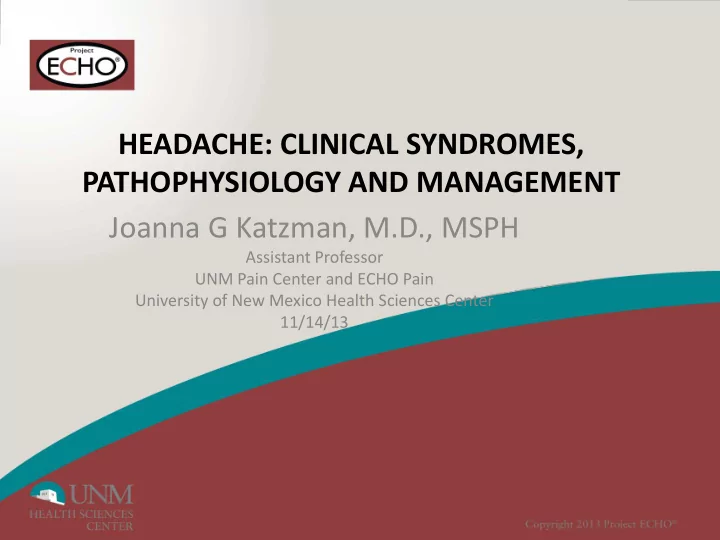

HEADACHE: CLINICAL SYNDROMES, PATHOPHYSIOLOGY AND MANAGEMENT Joanna G Katzman, M.D., MSPH Assistant Professor UNM Pain Center and ECHO Pain University of New Mexico Health Sciences Center 11/14/13
After this session, participants will be able to identify and treat various non-migraine headache syndromes, including: Medication Overuse Cluster Tension Ominous (PTC, Meningitis. SAH)
CLINICAL HEADACHE SYNDROMES 1. Migraine Headache 2. Cluster Headache 3. Tension-type Headache 4. Benign Intracranial Hypertension 5. Trigeminal Neuralgia 6. Cranial Arteritis 7. Subarachnoid Hemorrhage
MIGRAINE PATHOPHYSIOLOGY Migraine Aura Spreading depression in the cortex Release of Potassium Release of glutamate
The Trigeminovascular Theory Adapted from Lancet 1998;351:1045
MIGRAINE PATHOPHYSIOLOGY Pain Syndrome Trigeminal nucleus activated Calcitonin gene – related peptide (CGRP) released by trigeminal nerve CGRP release causes vasodilation Plasma protein extravasation causes sterile inflammation in the dura matter
MIGRAINE HEADACHE COMMON 1. No aura 2. With nausea, vomiting, photophobia 3. Sleep alleviates symptoms 4. Familial history likely 5. Unilateral, throbbing quality of pain
MIGRAINE HEADACHE CLASSICAL 1. With visual aura, such as scintillating scotoma or fortification spectra – thought to represent neuronal spreading depression within the occipital lobe 2. The remainder of clinical presentation is the same as with common migraine
MIGRAINE HEADACHE COMPLICATED 1. Involves significant neurological deficits 2. Recovery may take hours to days or weeks 3. Rarely may represent a stroke 4. Treatment should NOT include ergotamines or “ Triptans ”
Pharmacological Migraine Treatment ABORTIVE TREATMENT OF MIGRAINE a) 5-HT, receptor agonists (“ Triptans ”) Sumatriptan, Rizatriptan, Zolmitriptan, Naratriptan, Frovatriptan b) Ergot alkaloids Dihydroergomtamin Ergotamine c) Opioid analgesics d) Butorphanol Fiorinal/Fioricet
Comparative Clinical end points from selected trials of triptans
The Triptans: Stratification by patient needs
The Triptans: Stratification by patient needs
Pharmacological Migraine Treatment 1. Prophylactic Treatment of Migraine a) Beta-adrenergic blockers b) Calcium-channel blockers c) Tricyclic antidepressents d) Anti-epileptic drugs e) Nonsteroidal anti-inflammatory drugs f) Methysergide
AED Effects on Migraine Prevention (VPA* and TPM*)
STATUS MIGRAINOSIS 1. Duration of Migraine is greater than 48 hours. 2. Headache produces sufficient disability of debilitation to make presentation to the hospital warranted.
STATUS MIGRAINOSIS 3. Treatment includes rehydration and 3 possible protocols: a. Dihydregotamine (DHE) or b. “ Triptans ” or c. Corticosteroids
CLUSTER HEADACHE CLINICAL PRESENTATION 1. Occurs in males greater than females 2. Usually no family history 3. Headaches can occur up to 3 times a day over a several month period
Gender Distribution in Cluster Headache
CLUSTER HEADACHE CLINICAL PRESENTATION (continued) 4. Pain is abrupt in onset, unilateral and usually remains on the same side of the head from attack to attack 5. Attacks can last for 1-2 hours 6. Ipsilateral eye injected, nostril blocked 7. Partial Horner syndrome can occur
BOUT FREQUENCY
ASSOCIATED FEATURES
CLUSTER HEADACHE
PHARMACOLOGICAL CLUSTER TREATMENT 2. Abortive Treatment 1. Preventive Treatment of Cluster Headache of Cluster Headache a) Oxygen a) Verapamil b) Ergotamine b) Lithium c) DHE-45 c) Methysergide d) “ Triptans ” d) Valproate e) Corticosteroids f) 4% Lidocaine e) Ergotamine intranasally (ipsilateral to headache)
CHRONIC TENSION HEADACHE Occurs equally in women and men Usually related to musculoskeletal spasm of neck and shoulders Rebound headaches common from excessive symptomatic medications (ie. OTC preparations, opioid use, barbiturate combination therapies) Many patients have “mixed headaches”
TENSION HEADACHE
CHRONIC TENSION HEADACHE Successful treatment usually includes strong emphasis on non-pharmacologic management Physical therapy for neck Stretching Relaxation techniques Posture correction Heat to neck affected by muscle spasm
CHRONIC TENSION HEADACHE Pharmacologic management includes: Muscle relaxants Tricyclic anti-depressants Non-steroidal anti-inflammatory medications
PSEUDOTUMOR CEREBRI (BENIGN INTRACRANIAL HYPERTENSION) CLINICAL PRESENTATION 1. Women more commonly affected than men 2. Generalized headache 3. Pressure-related CN VI palsy 4. Papilledema 5. Visual field deficits with enlarged blind spots
PSEUDOTUMOR CEREBRI RISK FACTORS 6. Corticosteroid withdrawal 1. Addison’s disease 7. Tetracycline 2. Pregnancy 3. Hypervitaminosis A 8. Sulfa 4. Obesity 9. Radical Neck Surgery 5. Oral contraceptive use 10. Venous hypertension (e.g. COPD, CHF)
PSEUDOTUMOR CEREBRI MEDICAL TREATMENT 1. Acetazolamide 2. Low-dose corticosteroids
PSEUDOTUMOR CEREBRI SURGICAL TREATMENTS 1. Frequent lumbar punctures 2. Lumbar drains 3. Optic nerve sheath fenestration
TRIGEMINAL NEURALGIA (Tic Douloureux) CLINICAL PRESENTATION 1. Paroxysmal pain in distribution of CNV 2. Pain often triggered by trivial sensory stimulus (light touch, wind) 3. Each attack is short-lived (seconds) but tends to occur repetitively, with lingering facial pain
ETIOLOGY OF TRIGEMINAL NEURALGIA 1. Primary Trigeminal Neuralgia a) Idiopathic 2. Secondary Trigeminal Neuralgia a) CP angle tumor b) Meningioma (compressing Gasserian ganglia c) Cancer Infiltration of skull base 3. Bilateral Trigeminal Neuralgia a) Multiple Sclerosis
TRIGEMINAL NEURALGIA MEDICAL TREATMENT 1. Carbamazepine 2. Phenytoin 3. Clonazepam 4. Baclofen
TRIGEMINAL NEURALGIA SURGICAL TREATMENT Stereotactically controlled thermocoagulation of the trigeminal roots
CRANIAL ARTERITIS “Temporal Arteritis” CLINICAL PRESENTATION 1. Painful inflammation of the cranial arteries and general systemic symptoms. 2. Major vessels of the aorta, coronaries and limb arteries can be involved (periarteritis nodosa) 3. Headache not seen in all patients with cranial arteritis 4. Hyperalgesia of scalp 5. Frequently patients may suffer pain on mastication, pain in the ear, zygoma, nuchal regions and occiput
CRANIAL ARTERITIS “Temporal Arteritis” VISUAL COMPLICATION 1. Ocular symptoms may be the presenting complaint 2. More than one-third of patients are threatened with partial or complete loss of vision
SUBARACHNOID HEMORRHAGE NATURAL HISTORY 1. 5-10% of all strokes 2. Leading cause of SAH is due to rupture of saccular aneurysm 3. The 30-day mortality of SAH is nearly 50%
SUBARACHNOID HEMORRHAGE The most common sites are: 1. Anterior communicating artery 2. Posterior communicating artery and 3. Major bifurcation of middle cerebral artery 4. And, bifurcation of the ICA into MCA and ACA
DIAGNOSIS 1. 25% of cases of SAH are initially misdiagnosed 2. Laboratory tests 3. EKG abnormalities after SAH 4. Head CT 5-10% of patients with SAH will have normal scans 5. CSF Studies (especially when CT nl.) 6. Cerebral arteriography essentially after diagnosis made
MANAGEMENT OF SUBARACHNOID HEMORRHAGE 1. Intensive care unit 2. Seizure prophylaxis 3. Risk of cardiac arrhythmias and myocardial ischemia 4. Hypertension 5. Intracranial pressure monitoring 6. Hydrocephalus 7. Prevention of rebleeding
Recommend
More recommend